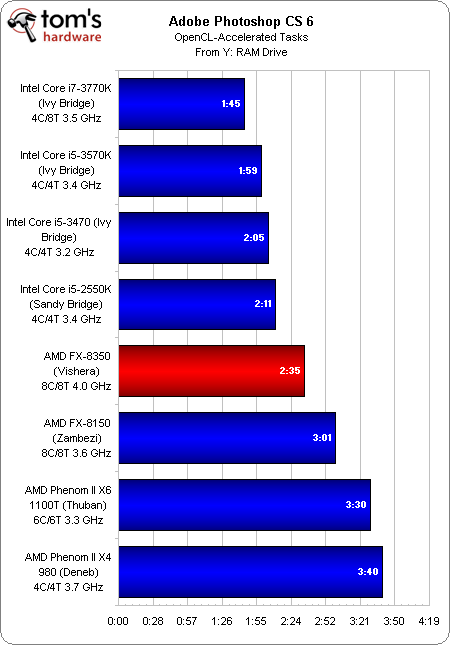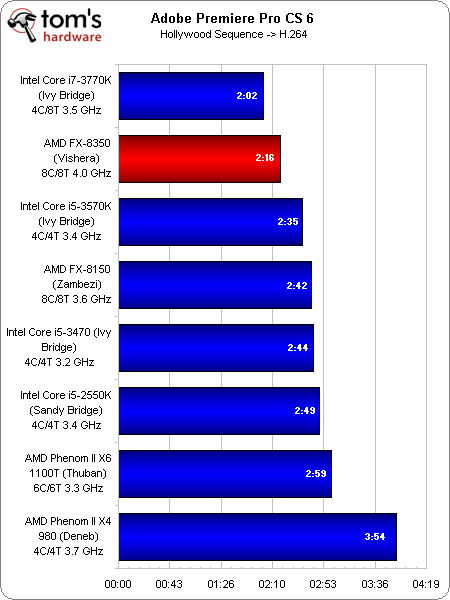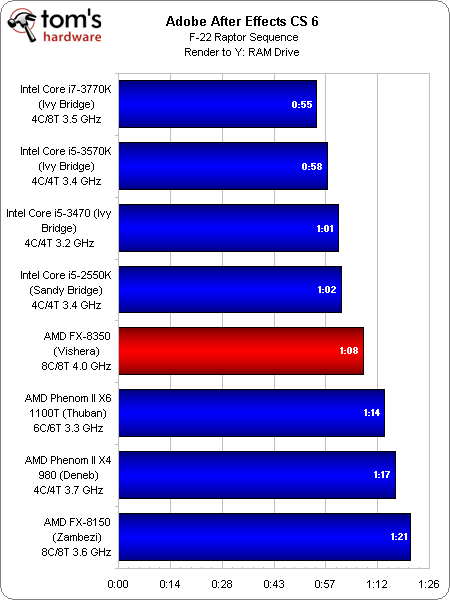AMD FX-8350 Review: Does Piledriver Fix Bulldozer's Flaws?
Last year, AMD launched its Bulldozer architecture to disappointed enthusiasts who were hoping to see the company rise to its former glory. Today, we get an FX processor based on the Piledriver update. Does it give power users something to celebrate?
Benchmark Results: Adobe CS 6
Our older Photoshop workload is composed of threaded filters able to tax each multi-core processor. Given the FX-8350’s first-place finish, it clearly scales to at least eight threads. The improvement over FX-8150 is quantifiable. Meanwhile, AMD’s older four- and six-core chips get left in the dust.
We have a second Photoshop benchmark that exploits the application’s support for OpenCL. The workload is completely different, so you can’t compare it to the chart above. That'd make sense though, since this test takes longer to run.
AMD’s platform just doesn’t do as well. It’s OpenCL-based, so Nvidia’s GeForce GTX 680 and PCI Express 2.0 do play a role. However, this is also a scenario AMD is telling us to expect more of moving forward, so I think it’s still very relevant. All four AMD chips slide back to the rear of the field behind Ivy and Sandy Bridge-based processors from Intel.
We move back over to workloads that isolate processor performance and AMD’s FX-8350 shows us what it’s working with once more. The FX-8150 didn’t do poorly in this test previously, so its position right behind the Core i5-3570K isn’t altogether surprising. But the -8350 soundly bests the Core i5 and pulls right up behind the Core i7. We’ve told this story before, and we know how it ends: when you’re dealing with a threaded application, AMD’s modular architecture does well.
At the same time, when you swap over to a usage model not as well adapted for parallelism, the module concept chokes up. After Effects CS 6 is no friendlier to AMD’s design than CS 5.5 was. A higher base clock rate does help the Piledriver-based FX-8350 land in front of the almost two-year-old Phenom II X6 1100T, but it trails the full complement of chips from Intel.
Get Tom's Hardware's best news and in-depth reviews, straight to your inbox.
Current page: Benchmark Results: Adobe CS 6
Prev Page Benchmark Results: Content Creation Next Page Benchmark Results: Productivity-
amuffin Looks like AMD did pretty well with the 8350.Reply
I now really don't see people purchasing it though....people will be buying the 8320. -
kracker Interesting, nice improvement over BD, it spars very closely or beats the i5-3570K sometimes, It really can't compete with intel's high end, but nevertheless good job AMD!Reply -
sixdegree AMD is doing good with the pricing this time. This is what AMD should be: aggressively priced CPU with added features.Reply -
esrever The price is actually nice this time. Hopefully AMD sticks around and gives good deals like this for years to come.Reply -
Nice job AMD. It just kept itself afloat! Not performance killer, but good enough to get a chunk of desktop sales just in time for the holiday season. Probably wouldn't buy it over an Intel system because most apps are still quite single threaded, but I would certainly consider it. Welcome back to the race AMD. Keep up the good work!Reply
-
najirion so... amd will still keep my local electric provider happy. Good job AMD but I think FM2 APUs are more promising. The fact that APUs alone can win against intel processors if discrete graphics is not involved. Perhaps AMD should focus in their APU line like integrating better gpus in those apus that will allow dual 7xxx graphics and not just dual 6xxx hybrid graphics. The entire FX architecture seems to have the issue with its high power consumption and poor single-thread performance. Better move on AMD...Reply -
dscudella I would have liked to see more Intel offerings in the Benchmarks. Say an i3-2120 & i3-3220 for comparisons sake as they'll be cheaper than the new Piledrivers.Reply
If more games / daily use apps start using more cores these new AMD's could really take off. -
EzioAs Interesting. Probably not a gamers first choice but for users who regularly use multi-threaded programs, the 8350 should be very compelling. About $30 cheaper than a 3570K and can be overclock as well, video/photo editors should really consider this. It doesn't beat current Intel CPUs in power efficiency but at least it's significantly more efficient than Bulldozer.Reply
Thanks for the review.
Btw Chris, how many cups of joe did you had to take for the overclocking testing? ;) -
sorry just not overly impressed.Reply
5-12% performance increase 12% less power - sound familiar?
the only difference this time was less hype before the release. (lesson well learned AMD!)
-
gorz I think the fx-4300 is going to be the new recommended budget gaming processor. Good price that is only going to get lower, and it has overclocking.Reply




